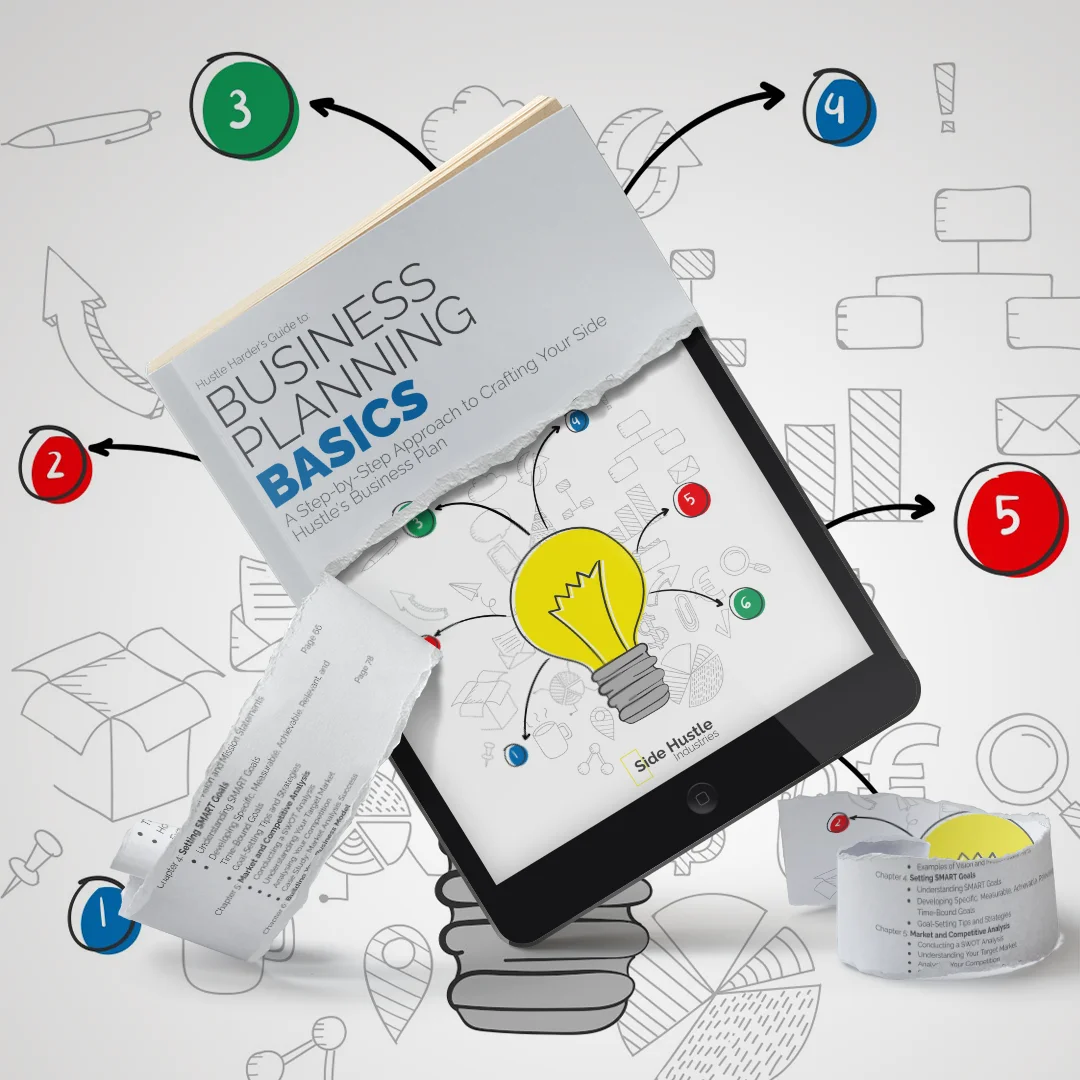
Defining your entrepreneurial goals is an essential first step on your journey toward building a successful side hustle. However, before you dive into goal pursuit, it’s crucial to conduct an honest and thorough self-assessment. This self-assessment involves evaluating your skills, strengths, weaknesses, and available resources. Understanding what you bring to the entrepreneurial table is as vital as setting your goals because it informs your strategy and determines your chances of success. In this blog, we will explore the importance of assessing your skills and resources and provide a practical guide to help you navigate this introspective process.
The Significance of Self-Assessment
The idea of starting a side hustle or small business can be exhilarating, but it’s also a venture filled with challenges and uncertainties. Knowing your own capabilities, limitations, and the resources at your disposal is a fundamental aspect of risk management and planning. Self-assessment offers the following benefits:
1. Identifying Strengths: Recognizing your strengths helps you understand what you excel at. These strengths can be leveraged to build and grow your side hustle. Your unique skills might be the differentiator that sets you apart in a competitive market.
2. Acknowledging Weaknesses: Identifying your weaknesses is equally important. It allows you to take a proactive approach in addressing these areas, either through personal development, outsourcing, or collaboration with others.
3. Resource Allocation: Understanding your available resources, whether they are financial, human, or time-related, is crucial for efficient resource allocation. It prevents overcommitting and burning out early in your entrepreneurial journey.
4. Building a Strong Foundation: Self-assessment is the cornerstone of building a strong and realistic business plan. It ensures that your goals align with your skills, and that the strategies you develop are feasible given your resources.
5. Risk Management: Self-assessment helps you identify potential risks and challenges, allowing you to devise contingency plans and mitigate potential setbacks.
Skills Assessment
As an aspiring or existing entrepreneur, your skills form the foundation of your side hustle. Your unique combination of abilities, knowledge, and experiences can be a powerful asset in the business world. To conduct a comprehensive skills assessment, consider the following steps:
1. Inventory Your Skills:
Begin by creating a list of your skills, both hard (technical) and soft (interpersonal). Hard skills could include web design, coding, or financial analysis. Soft skills might involve communication, leadership, or problem-solving.
Reflect on your past work experiences, hobbies, and education to identify the skills you’ve acquired.
2. Self-Reflect on Strengths and Weaknesses:
Once you’ve listed your skills, evaluate your proficiency in each one. Identify your strengths—those skills you excel at and feel confident in.
Also, acknowledge your weaknesses. These are the skills where you might have limited experience or struggle. Being aware of your weaknesses allows you to plan for support or growth in these areas.
3. Seek Feedback:
Ask for feedback from mentors, colleagues, or friends who can provide an objective perspective on your skills. They might identify strengths or weaknesses you hadn’t considered.
4. Prioritise:
Prioritise your skills based on relevance to your entrepreneurial goals. The skills at the top of your list are those that will be most instrumental in your side hustle’s success.
5. Continuous Learning:
Recognize that skills can be developed and refined. If you identify skills gaps that are critical to your business, consider investing in training, online courses, or mentorship to improve.
6. Leverage Your Network:
Surround yourself with people who possess complementary skills. Collaborating with individuals who excel in areas where you’re weaker can be a strategic move.

Real-Life Example: Skills Assessment
Imagine you’re passionate about food and want to start a catering business. Your skills assessment might look like this:
Inventory of Skills:
Hard Skills:
- Culinary skills
- Menu planning
- Food presentation
- Food safety and hygiene
- Inventory management
Soft Skills:
- Communication
- Adaptability
- Time management
- Problem-solving
- Customer service
Self-Reflection:
Strengths: Your culinary skills and food presentation are exceptional. You have experience in managing a restaurant kitchen and a deep passion for food.
Weaknesses: Your inventory management skills are limited. You also acknowledge that your time management can be improved, especially when dealing with multiple catering events.
Seeking Feedback:
You ask a former colleague who is an experienced event planner for feedback. She highlights your excellent communication skills but suggests that time management and inventory management could be areas for improvement.
Prioritisation:
You recognize that culinary skills, menu planning, and communication are your top priorities, as they are most directly related to the success of your catering business.
Continuous Learning:
You decide to take an online course on inventory management to address your skill gap in this area. You also seek mentorship from a fellow chef who excels in time management.
Leveraging Your Network:
You connect with a friend who has strong organisational and time management skills, and you decide to collaborate on event scheduling and logistics.
Resource Assessment
In addition to skills, your side hustle’s success is influenced by the resources at your disposal. Resources can include financial capital, time, physical assets, knowledge, and human capital. To assess your available resources, consider the following steps:
1. Financial Resources:
Review your financial situation, including savings, investments, loans, or any available funds. Determine how much capital you can allocate to your side hustle.
2. Time Availability:
Assess the amount of time you can realistically dedicate to your side hustle. Consider your current work commitments, family responsibilities, and other personal priorities.
3. Physical Assets:
Identify any physical assets or equipment you already possess that could be used in your side hustle. This might include a computer, kitchen appliances, tools, or a vehicle.
4. Human Capital:
Determine if you have access to individuals with valuable expertise, whether they are family members, friends, or professional contacts. These individuals can provide guidance and support.
5. Knowledge and Expertise:
Recognize your areas of expertise or specialised knowledge. Whether it’s in a specific industry, technology, or craft, your knowledge can be a valuable resource.
6. Networking and Relationships:
Your network of contacts can be a resource in terms of support, advice, and potential business partnerships.
7. Liabilities:
Consider any existing financial or legal liabilities, such as outstanding debts or obligations that might affect your side hustle.
8. Legal and Regulatory Factors:
Be aware of any legal or regulatory considerations related to your business, as these can impact your resources and planning.
Real-Life Example: Resource Assessment
Continuing with the catering business example, your resource assessment might look like this:
Financial Resources:
You have $20,000 in savings that you’re willing to invest in your catering business. This includes funds for purchasing kitchen equipment, marketing, and initial overhead costs.
Time Availability:
You currently work part-time as a chef in a restaurant, leaving you with approximately 30 hours per week to devote to your side hustle. You’re confident that your part-time work can be adjusted to accommodate your catering business.
Physical Assets:
You already own a set of high-quality kitchen knives, kitchen utensils, and a collection of cookware. You also have access to a commercial kitchen space through your restaurant job, which reduces your initial overhead costs.
Human Capital:
A close friend is an experienced event planner and has offered to collaborate with you on catering events. You also have connections in the local food industry, which could lead to business opportunities and advice.
Knowledge and Expertise:
Your culinary expertise and passion for food make you well-equipped to create exceptional dishes and design a unique catering menu.
Networking and Relationships:
Your restaurant job has provided you with a network of local food suppliers and potential clients who have shown interest in your catering services.
Liabilities:
You have an outstanding car loan but no other significant financial liabilities. You ensure that your business plan includes a strategy for repaying this loan while growing your side hustle.
Legal and Regulatory Factors:
You’re aware of health and safety regulations related to food preparation and catering in your area. You plan to follow these regulations closely to ensure compliance.
By conducting a thorough resource assessment, you have a clear understanding of what you have available to support your catering business. This knowledge informs your business plan, financial projections, and strategic decisions as you move forward.

Aligning Skills and Resources with Goals
The ultimate goal of assessing your skills and resources is to align them with your entrepreneurial goals. The harmony between what you bring to the table and the objectives you’ve set ensures that you’re setting yourself up for a higher chance of success. Here’s how to align your skills and resources with your goals:
1. Goal Relevance:
Evaluate whether your skills and resources are relevant to your entrepreneurial goals. Your goals should be achievable based on what you have to offer.
2. Skills Enhancement:
Consider how you can enhance your skills to better meet your goals. If a specific skill is crucial but currently a weakness, invest in training or mentorship to improve.
3. Resource Allocation:
Allocate your resources effectively to support your goals. If your financial resources are limited, focus on short-term goals that require fewer initial investments.
4. Resource Maximisation:
Maximise the use of your physical assets and human capital. Leverage your connections, equipment, and knowledge to reduce overhead costs and enhance the quality of your products or services.
5. Collaboration and Networking:
Collaborate with individuals in your network who possess skills and resources that complement your own. These partnerships can fill gaps and accelerate your progress.
6. Goal Adjustments:
If, after assessment, you realize that your skills and resources don’t align with your initial goals, be open to adjusting your goals to better match your capabilities. It’s essential to set goals that are both challenging and attainable.
Real-Life Example: Aligning Skills and Resources with Goals
In the catering business example, you’ve set the following entrepreneurial goals:
- Goal 1: Establish a fully operational catering business within the first year.
- Goal 2: Secure at least ten catering contracts for various events within the first six months.
- Goal 3: Achieve a 20% growth in catering revenue every quarter during the first year.
Goal Relevance:
Your culinary skills, kitchen equipment, and access to a commercial kitchen make these goals highly relevant. You’re confident in your ability to prepare and serve exceptional food.
Skills Enhancement:
You’re working on improving your time management skills, which are essential for goal attainment.
Resource Allocation:
Your initial financial investment aligns with your first goal of establishing the catering business within the first year.
Resource Maximisation:
Leveraging your commercial kitchen access and close friend’s event planning skills will maximise your resources.
Collaboration and Networking:
Collaborating with your friend in event planning will significantly enhance your capacity to secure catering contracts.
Goal Adjustments:
If, during your journey, you encounter unexpected challenges that make it difficult to achieve your growth goal, you’re open to adjusting your growth rate to ensure sustainable progress.
By aligning your skills and resources with your goals, you’re optimising your chances of success and minimising the risk of overextension or resource misallocation.
Assessing your skills and resources is a vital preparatory step for any entrepreneur. It provides a realistic perspective on your entrepreneurial journey, informs your business plan, and enhances your decision-making. Recognizing your strengths and weaknesses allows you to leverage your talents effectively, while understanding your available resources helps you allocate them optimally. The alignment of skills, resources, and goals sets you on the path to building a successful side hustle.

*Also available on Amazon in Kindle, Soft Cover & Hard Cover formats. —> Click Here.
